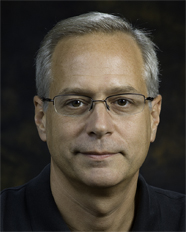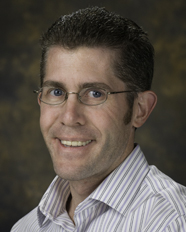QSB Core Faculty
 |
Luis A.N. Amaral
|
|
 |
Xiaomin BaoThe Bao lab uses human skin as a model system to study the epigenomic regulation of progenitor maintenance and tissue differentiation. We are interested in how chromatin architecture and modifications dictate gene expression in a genomewide scale. More Information E-mail: xiaomin.bao@northwestern.edu |
|
|
|
Greg BeitelThe Beitel lab uses ChIPseq and RNA seq to investigate the molecular mechanisms of epithelial morphogenesis and cellular responses to elevated CO2 levels (hypercapnia). The Beitel lab is investigating forces in the morphogenesis of epithelial tubes, using the Drosophila trachea as a model system. We are developing methods to create a mathematical model of tubes from confocal images stacks, which will then be used analyse cell, junctional and protein dynamics and distributions. Image analysis and segmentation uses tools including Ilastik, Matlab and Fiji. Segmentation and image analysis code is developed in Matlab, statistical analysis using Matlab. More Information E-mail: beitel@northwestern.edu |
|
 |
Rosemary BraunThe Braun Lab develops and applies powerful mathematical and computational techniques to investigate living systems at multiple scales — from the atomic level, to the gene level, to the systems level, to the tissue/organismal level, and finally to the population level — and apply these methods in close collaboration with experimentalists and clinicians to address pressing biomedical questions, from circadian disruption to cancer. More Information E-mail: rbraun@northwestern.edu
|
|
 |
Jason BricknerThe Brickner lab seeks to understand the spatial arrangement of the genome inside the nucleus and how this impacts gene expression. More Information E-mail: j-brickner@northwestern.edu |
|
 |
Richard CarthewThe Carthew lab uses systems biology to study gene expression dynamics during animal development, specifically in Drosophila. We apply highthroughput image analysis of single cell quantitative expression of proteins and mRNAs, coupled with ODE modeling of expression dynamics. More Information E-mail: r-carthew@northwestern.edu |
|
 |
Juan DuThe Du lab and Lü lab are dedicated to unraveling the complexities of sensory perception—how the human body detects external stimuli, transmits these signals to the brain, and elicits appropriate responses through the intricate network of neuronal ion channels. A particular focus of our work is on understanding the biophysical mechanisms underlying temperature sensation and taste perception. These fundamental aspects of sensory processing offer profound insights into human physiology and potential therapeutic avenues for a range of conditions. More Information E-mail: juan.du@northwestern.edu |
|
 |
Curt HorvathThe Horvath lab uses quantitative methods to understand the molecular basis of signal transduction and gene expression in cytokineregulated human systems including innate antiviral immune recognition and responses as well as normal and malignant control of gene expression. More Information E-mail: horvath@northwestern.edu |
|
 |
Neil KelleherThe Kelleher research group uses mass spectrometry-based proteomics and advanced informatics to study cell fate and decision making in proliferation and cellular senescence. Further, in collaboration with dozens of other laboratories, the group advances a variety of projects in basic and translational research from yeast to human patients. More Information E-mail: n-kelleher@northwestern.edu |
|
 |
Carole LaBonneThe LaBonne lab uses biochemical and computational approaches to understand the genetic and epigenetic control of the stem cell state, and the relationship of “stemness” to the capacity for invasive cell behavior. We use in vivo approaches in developing vertebrate embryos, and ex vivo analyses, to elucidate the contributions of retained cellular potential to the evolution of vertebrate animal such as humans. More Information E-mail: clabonne@northwestern.edu |
|
 |
|
|
 |
|
|
 |
John MarkoThe Marko lab studies chromosome organization and dynamics, DNAprotein interactions, DNA topology and topology control, nanonewton and piconewton force measurement. More Information E-mail: john-marko@northwestern.edu |
|
 |
Rick MorimotoThe Morimoto lab uses the quantitative analysis of integrated cell stress responses from the single cell to organismal level to elucidate the properties and structure of stress signaling pathways and proteostasis networks that protect the proteome from damage, ageassociated decline and risk for degenerative diseases. Our work incorporates mathematical and predictive modeling, genomic, transcriptomic and proteomic analyses and hypothesisdriven experimentation to validate network development. More Information E-mail: r-morimoto@northwestern.edu |
|
 |
Chris PetersenThe Petersen lab investigates the molecular basis for tissue regeneration and control of adult pluripotent stem cells using the planarian model system, Schmidtea mediterranea. Using next generation sequencing, high content RNAi screening and quantitative imaging, we investigate injury signaling, the reestablishment of tissue regionality, control of growth and the assembly of differentiated structures. More Information E-mail: christian-p-petersen@northwestern.edu |
|
 |
Ishwar RadhakrishnanThe Radhakrishnan lab focuses on the Sin3L/S HDAC and KAT2B HAT complexes and we are using biochemical, computational, and structural approaches including crystallography and cryoEM approaches. More InformationE-mail: i-radharkrishnan@northwestern.edu |
|
 |
Reza VafabakhshThe Vafabakhsh lab focuses on acquiring a quantitative mechanistic characterization of synaptic players at different length scales, from a single protein to the synapse level, to describe this complexity and towards an understanding of the molecular nature of information processing in the brain. We do so by developing quantitative biophysical and cell biology analyses using cutting edge single molecule and high throughput approaches that draw from cell biology, chemistry, physics and engineering. More Information E-mail: reza.vafabakhsh@northwestern.edu |
|
 |
Alec WangThe Wang lab uses genomics approaches to investigate regulatory pathways in mammalian stem cells. First, we are interested in how the nucleosome organization influences gene expression. Second, we are investigating how RNA ligases regulate cellular stress responses. More Information E-mail: awang@northwestern.edu |
|
 |
Ji-Ping WangMy research interests are in the statistical applications in biology and medical sciences. My recent work concerns developing statistical methods and tools for large-scale, high-dimensional genomic, genetic and human brain mapping data. More Information E-mail: jzwang@northwestern.edu |
